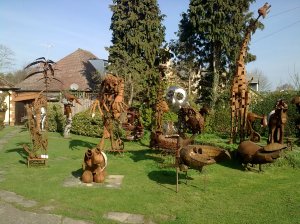August 31st, 2010. A two-hour stroll round the village bounds before sunset. The evening is dry, sunny and still, and after a wet and windy month all the more so. Only the faintest patterns and tracings of high cirrus cloud marble the pale blueness of sky. Gone are the dry acres, parched lawns and cracked ground of summer. The land is once again green. The gently rollicking pastures dip and rise under a close new turf. Verges and banks have sprung a thick crop of grass, field ditches filled, fulfilled, now falling, foliage washed clean, though there are very few flowers out at this time of year: amongst them, the flat off-white heads of yarrow, sometimes pink, the little two-toned yellow toadflax, the mealy, grey-green couscous balls of fat hen, and the clear yellow sprays of Canadian goldenrod, a garden escape; also, well into their season and still flowering, the lipped orchid-like mouths of the white dead-nettle, in whorls up the stem, the five purple-veined pink petals of the common mallow, and up the ravaged guided-busway still a few white campions and the last yellow flowers on the great spikes of mullein, with downy leaves as soft as lambs’ ears.
In the flat open paddocks to the west of the village a mixed party of wagtails flits nimbly about the horses’ hooves and blowing muzzles, picking off invisible insects disturbed by the great animals as they slowly tread forward, step by step, grazing green blades. I have hardly seen any of these ground-hugging birds this year. The five British species are difficult to identify, with summer and winter, and adult and juvenile variations in plumage. These are mostly, I think, grey wagtails, the first I’ve seen, with lemon yellow underparts, though they could be summer visiting yellow wagtails, or both. Amongst them is a solitary pied wagtail, or it could be a juvenile yellow. Who knows? What pleases me though is the way these slim, delicate creatures and towering muscled horses, unlikely companions, move forward together, at ease and as one.
Beck Brook is a respectable stream once again, knee-deep in water. Peering over the edge of a footbridge, a slow, jerky movement on the bottom catches my eye. And there it is, surely the weirdest creature in these parts – a crayfish, lumbering through the brickbats, lumps of concrete, bits of iron pipe and odd bicycle wheel that litter the muddy bed of our brook at this point. I had been told there were crayfish here, and I must have stared into this very same bit of water fifty times this year and never caught a glimpse of one. It is uniformly brown with a sheen of green, like the mud around it, with no distinguishing markings, about 6 or 7 inches long – a primordial iron-plated bulldozer with two enormous grabbing claws. The bulging eyes on top of its head, long black antennae waving around, multiple legs, segmented body and strange, blunt, fan-shaped tail-plate are grotesquely alien by any standard. This is probably the American Signal Crayfish (with bright red undersides to the claws, which I cannot see) that has almost wiped out our smaller native White-clawed Crayfish. I spot another, some six feet away from the first, but this one is missing a claw and about two-thirds of one antenna – a heron perhaps, or mugged by another male? It seems none the worse for wear. I toy with the idea of catching these two and having them for supper, if indeed they are Americans (the native English is protected) but, as hungry as I am, they are pretty repellent and ‘er indoors would be less than pleased with my foraging.
From a distance, the trees on the northern edge of Histon have taken on a bronzed, autumnal tint. But these are horse-chestnuts, their leaves curled and riddled and burnt with disease, prematurely aged by blight and the leaf-miner moth. It is the same everywhere now – you can pick out the horse-chestnuts from a mile away. Much of the wheat has been harvested (though still some stands), leaving great stretches of stubble studded with rolls of straw the size of small cars. Agricultural machinery grinds and trundles in a far field, and the village roads are busy with tractors. All this noise and activity however doesn’t disturb the smooth, mind-stopping tranquility of a late summer’s evening. Swallows still weave and loop through the air, a small flock of goldfinches dive into a hedge one after another, and a single grey heron lopes off into the pale lilac sky. Yet all is utterly still.





